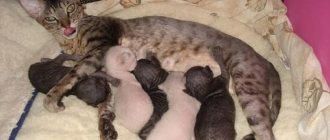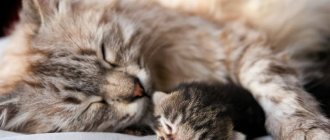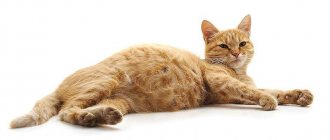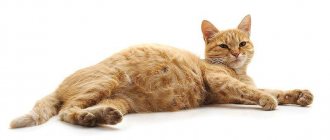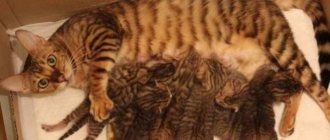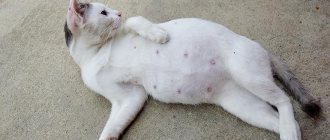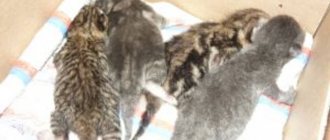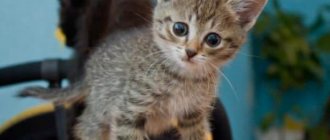Surgical manipulation - caesarean section, is performed in cats and dogs when problems arise during the birth process. As a rule, the main indication for surgical intervention is the inability to give birth physiologically. There may be planned operations, but most often emergency surgery is performed.
If the cat is not kept by the owner for breeding, veterinary experts recommend sterilization during cesarean section, which will avoid diseases in the reproductive sphere or minimize the risks of their occurrence.
What to feed a cat after a caesarean section
Cat after cesarean and SOS kittens
I really ask for your support... Yesterday, after a day of unsuccessful childbirth, my cat was cesareaned. Two kittens got stuck in the birth canal and died, two are alive. The cat does not feed them, growls at them and wants to bite. I feed them almost around the clock, slept less than two hours a night, ran from the cat to the kittens. They squeak all the time and ask to eat, they are ready to eat once every half hour, I feed once an hour and a half (Kitty Milk mixture). They don’t poop at all, it’s clear that they are restless, I’m in despair, I have two children, 2 and 5 years old and with There’s so much trouble with kittens, I’m sitting here crying, I don’t know how to get a cat used to them?? What should I do? SOS. Beloved daughters Olechka 12/26/2005 and Katerina 04/17/2009
Massaging. One pooped, but with screams there was hard feces, similar to meconium. lie on the heating pad constantly. How long should you massage your tummy and how long should you wipe your pussy and butt? Beloved daughters Olechka 12/26/2005 and Katerina 04/17/2009
Cat after birth: possible problems and complications
Greenish and reddish discharge in a cat after childbirth is normal, unless accompanied by fever, vomiting and diarrhea. Otherwise, you should consult a doctor.
If the cat breathes frequently immediately immediately after giving birth, and this condition lasts no more than 5-10 minutes, then everything is fine. Otherwise, you should consult a doctor.
Diarrhea and vomiting after giving birth in a cat are a sign that the cat has eaten too much afterbirth. Everything should go away within 24-48 hours. Otherwise, you should consult a doctor.
If a cat has constipation after giving birth, then, as always, in such cases, it is necessary to give the pet Vaseline or olive oil. If stool does not appear within 24 hours, you should consult a doctor.
Lactation in cats is caused by the sucking of kittens; experienced cats themselves push the kittens towards themselves; to inexperienced cats, the owner must attach the cubs. If one of the
Source
As an example for you, frequent estrus can be a consequence of early polycystic ovary syndrome. I personally saw what kind of garlands are taken out of cats. IMHO, breeding such a cat is not an effective treatment and does not produce healthy offspring. If I have a cat that leaked by 9 months, I will run it through all the tests before dragging it to the cat (ultrasound, hormones at a minimum). My opinion is that a healthy cat should carry kittens and give birth, and nothing else.
I have a cat who began to leak at 5 and a half months, and as it was said here, she leaked by 9 months and later and almost every two weeks - the doctors said that she was healthy - she gave birth to one kitten weighing 80 grams through cesarean section at the age of one and a half years - the surgeon said that he doesn’t understand why she couldn’t give birth - all female organs are healthy - that’s how things are -
The surgeon left the cat the opportunity to give birth - (after cesarean she nursed) and this did not prevent her from having a leak every two weeks - when she recovers, I’ll try to mate her with another cat (the breeder said that there was no bleeding) if the same picture occurs, I’ll immediately sterilize
“He immediately comprehended the perfection and completeness of my words, and before I could finish speaking, I felt that I was intoxicated with the purity of his heart.”
As an example for you, frequent estrus can be a consequence of early polycystic ovary syndrome. I personally saw what kind of garlands are taken out of cats. IMHO, breeding such a cat is not an effective treatment and does not produce healthy offspring. If I have a cat that leaked by 9 months, I will run it through all the tests before dragging it to the cat (ultrasound, hormones at a minimum). My opinion is that a healthy cat should carry kittens and give birth, and nothing else.
I have a cat who began to leak at 5 and a half months, and as it was said here, she leaked by 9 months and later and almost every two weeks - the doctors said that she was healthy - she gave birth to one kitten weighing 80 grams through cesarean section at the age of one and a half years - the surgeon said that he doesn't understand why
Source
Doctor's comment
Are you worried about the upcoming operation to remove an incompetent scar on the uterus? However, the proprietary technique used in our clinic excludes the development of any complications during the intervention. Thanks to the practiced methods of anesthesia and modern painkillers, the patient does not experience pain either during metroplasty or after removal of the uterine scar. The laparoscopic method used in our clinic also makes it possible to reduce the length of hospitalization to a minimum; after 1.5 months you can return to your usual physical activities. But the most important thing is that after treatment of the uterine scar, it becomes possible to carry and give birth to a child naturally. If you are just planning an examination, in our clinic you can undergo all the necessary procedures, after which treatment tactics will be selected taking into account the characteristics of your body. Do not delay treatment, because correct diagnosis and timely correction are the first step to happy motherhood!
Head of the surgical service at SwissClinic Konstantin Viktorovich Puchkov
A nursing cat has one nipple that is hard and inflamed
Is it a hard nipple or the entire breast lobe with milk? What age are the kittens? Mastometrin and Traumatin can be injected for 5 days, 1 ml subcutaneously; it will not hurt, but it may not help. Is this nipple sucked by kittens?
The antibiotic (especially the latest generation) is perfectly compatible with kittens: in particular, after cesarean section, cats are injected with an antibiotic, but at the same time they feed the kittens - no one has died from this yet. If the inflammation is severe, then no homeopathy will help. It looks like mastitis, the milk in this breast has curdled, it needs to be expressed in any way (massage), and the entire milk lobe should be smeared with an anti-inflammatory and analgesic.
For your cat, give a circular massage of the chest around the nipple, try to express from there, from homeopathy - as advised above - Traumatine and mastometrium help a lot.
But this may not be stagnation of milk, but a more serious illness, when surgical intervention is already necessary - so it is better not to self-medicate and quickly see a doctor.
I have a question for TS. And if it turns out that your cat needs surgery, will you ask on the forums how to do it yourself in the kitchen? If you admit the possibility of turning to the vet in case of emergency, then it is your duty to turn to him BEFORE the situation reaches this extreme.
The kittens are 2 days old, the lump has swelled in 24 hours, almost the size of a chicken egg. Before giving birth, the nipple was 2 centimeters, hard and dry. The kittens can’t suck on it; the nipple is flat and there’s nothing to grab onto. We make compresses from potatoes and cabbage. Veterinarians suggest a blockade with antibiotics. But no stranger will be able to take it in his hands - he will tear it, and his own for one. There was already a contender when she was brought in with poisoning, barely alive. Where did the strength come from? seasoned regional doctors were in shock. They threw on a blanket and gave me a double dose of anesthesia. We waited a long time for her to calm down. Then pr
Source
Brief information about the technique of the operation
In general, it is not so important for the owners how exactly the operation takes place (you won’t do it in your bathroom, will you?), so we will limit ourselves to brief information. After cutting the hair and disinfecting the surgical field, the veterinarian makes an incision along the white line (most often), takes out the uterus, fixes it, makes an incision, and takes out the kittens. After this, the placenta is removed and the remaining fetal fluids are sucked out. Antibacterial drugs are placed in the uterine cavity, which prevent sepsis from purulent endometritis (more precisely, reduce the risk of the latter). Everything is sutured in the reverse order, and an insulating bandage is applied to the outer seam. Naturally, all this is done under general anesthesia.
Cat after cesarean
Cat after cesarean and SOS kittens
I really ask for your support... Yesterday, after a day of unsuccessful childbirth, my cat was cesareaned. Two kittens got stuck in the birth canal and died, two are alive. The cat does not feed them, growls at them and wants to bite. I feed them almost around the clock, slept less than two hours a night, ran from the cat to the kittens. They squeak all the time and ask to eat, they are ready to eat once every half hour, I feed once an hour and a half (Kitty Milk mixture). They don’t poop at all, it’s clear that they are restless, I’m in despair, I have two children, 2 and 5 years old and with There’s so much trouble with kittens, I’m sitting here crying, I don’t know how to get a cat used to them?? What should I do? SOS. Beloved daughters Olechka 12/26/2005 and Katerina 04/17/2009
Massaging. One pooped, but with screams there was hard feces, similar to meconium. lie on the heating pad constantly. How long should you massage your tummy and how long should you wipe your pussy and butt? Beloved daughters Olechka 12/26/2005 and Katerina 04/17/2009
After a successful birth without complications, the cat will have postpartum discharge that lasts from 7 to 21 days. Normal discharge from a cat after giving birth is not too heavy, reddish or brownish in color, which gradually turns green and stops over time. It is important to monitor the pet’s condition and behavior, which should be unchanged and stable.
It is rare for a cat to bleed after giving birth in the case of an easy, problem-free delivery. As a rule, in this case this means some kind of pathology. But these are isolated cases. Bleeding after giving birth in a cat can be caused by rupture or damage to the birth canal by a large fetus, retention of the kitten or placenta in the birth canal during birth, problems with the reverse development of the uterus after birth (it should shrink to its previous size, this process is called subinvolution in veterinary medicine). If a cat is bleeding after giving birth, be sure to carefully monitor its condition: measure the temperature
Source
Advantages of laparoscopic reconstructive metroplasty
- Low-invasiveness - thanks to the use of video endoscopic equipment, only the scar is excised, the surrounding tissues are minimally affected
- No blood loss
- Reliable suturing - thanks to the author’s technique used, pregnancy and childbirth naturally become possible in the future
- The use of anti-adhesive barriers during surgery on the uterine scar reduces the risk of formation of adhesions
- Short rehabilitation period and minimal hospitalization period
- Fast recovery after
- Excellent cosmetic result - only three barely noticeable marks remain on the skin.
How many months does a pregnant cat last?
One of the most important moments in a domestic cat's life is pregnancy. In addition to the complexity of the birth process itself, there are many problems that arise during the period of gestation of kittens. Any responsible owner needs to know the approximate day of fertilization in order to calculate the expected date of birth and prepare for this day.
Mating in cats
The amount of sex hormones responsible for mating in cats reaches the required level already by approximately 8–9 months of the first year of life . However, the size and breed of the animal have a significant influence. It is at this age that a cat can first begin to roll on the floor and meow protractedly, inviting potential suitors. This alarming behavior often causes inconvenience for owners, but still there is no need to rush and look for a suitable match for her.
The first heat should be skipped, because physiologically and psychologically the cat is not yet ready to bear offspring. According to statistics, cats that are untied early are more likely to abandon their kittens or have miscarriages. In addition, pregnancy at this age can lead to injuries, hormonal problems and spinal curvature in some breeds. Experts consider the ideal age for the first mating to be one and a half years. For some breeds, the age limit is raised to two years.
There is one of the unshakable rules of mating: A cat is brought to a cat, and not vice versa . This is due to the nature of the animals themselves - it is easier for a cat to court a lady on his territory, he is not as nervous as when moving. Before mating, it is recommended to conduct a clinical examination of the cat for existing viral diseases, get rid of possible worms and fleas, and trim the claws. Most often, owners must take care of food and water bowls, food and the usual litter for their pet.
Source
Many people dream of becoming owners of purebred cats, but not everyone knows that breeding Persians is not only an interesting activity that gives a lot of joy and pleasure, but also a great responsibility. In addition, this will require a lot of effort, time and money from a person. A person needs to clearly formulate the goal for which he wants to start a business. He must be well aware that many difficulties may arise along the way.
Those who have decided to engage in breeding work, first of all, need to know everything about the breeding cycle of furry pets, how pregnancy and childbirth proceed in cats, and also how best to choose a partner for mating. The breeder may face the death of a cat during childbirth or in the postpartum period.
He may be faced with the task of artificial feeding and caring for orphaned kittens. Will the owner be able to devote enough time to caring for a cat who has had a cesarean section, as well as taking care of the newborns until the mother is able to care for them again? The breeder must be able to cope with any difficulties, be it the treatment of animals or large material costs.
Perhaps the first sign of the approaching spring can be considered cat concerts, in which not only stray animals, but also pets take part. Naturally, heartbreaking screams for several days and even weeks do not bring pleasure to anyone, so you should somehow pacify the furry pupil’s love fervor.
What sounds do animals make?
The most effective way to completely discourage your pet from walking under the moon is to castrate him (remove his testicles). The best time to perform the operation is 6–8 months of age, when the formation of skeletal bones in cats is completed (it is believed that sex hormones are necessary for their normal growth). It will be easier for an animal that is castrated at a young age to survive this
Source
Help me please. Is it possible to save a kitten whose milk has entered its lungs? He barely breathes, no longer meows, only opens his mouth. Doesn't hold the head, weighs like a rag. The kitten is 3 days old. The cat's mother, after a cesarean section, didn't let her in regularly for the first few days. What to do? or it's already useless.
She has 6 kittens. Today they did not feed them. She already went to bed with them today. Mostly we slept quietly with her, hanging on her nipples for 2 or more hours. And half an hour ago I noticed that one was lying at a distance and had his mouth open. She took him in her arms and...
A healthy kitten cannot get milk into its lungs. If a three-day-old baby dies, it means there is some serious pathology. The critical age is five days, the next critical age is ten days. Newborns with disorders incompatible with life die during this time. This is Mother Nature's most important defense mechanism. And there is no need to save them. Besides the fact that it is stupid to go against nature, think for yourself: who needs a freak cat or a disabled cat?
Crap. where did you get the idea that milk is in the lungs? Does mom lick him? Have you supplemented your baby's feeding if the mother won't let you? How often? Does he sleep with mom or separately?
You need to take the kitten in your palm, fix the head between the thumb and forefinger and forcefully shake the kitten down with its head as if you wanted to forcefully throw it on the floor, and so on several times. Then wrap it in a waffle towel and rub it vigorously until it begins to squeak.
I have been breeding for a long time and in such a situation a puppy survived only 1 time. the rest died no matter how hard I tried. if a weak cat takes and takes healthy kittens to another place and the sick one is left to die
We are constantly adding new functionality to the main interface of the project. Unfortunately, older browsers are not able to work well with modern software products. For correct operation
Caesarean section in a cat
A caesarean section in a cat is an abdominal operation, performed during childbirth, newborn kittens are removed through a small incision in the uterus.
Surgical intervention is carried out by an obstetrician at the Dobrovet Center if the cat goes through strong contractions and attempts within an hour, but not a single baby is born. Also, a caesarean section is indicated in case of postmaturity, and labor did not occur 63-70 days after mating.
A caesarean section on a cat can be performed at home, the price in case of an emergency call to the doctor, or in a hospital setting, in case of planned surgical intervention, is agreed upon in advance.
A caesarean section in a cat is performed under general anesthesia; gas anesthesia is recommended, since it has much less side effects on the body than with injection.
Newborns are applied to the nipples as soon as the cat recovers from anesthesia. Due to the fact that the natural course of “events” has been disrupted, the cat cannot immediately accept the babies, but, as a rule, after a while she begins to feed them.
If the cat is weak after a cesarean section or the litter is too large, you can feed the kittens in small groups or artificially feed them.
Important! Close the seam as much as possible and protect it so that kittens do not damage it with their claws. When the cat is not feeding the babies, it is better to keep them in a warm box (a heating pad) separately.
If the reason for the caesarean section was not due to anatomical features (narrowness of the birth canal), then the animal can subsequently be allowed for breeding. However, it is recommended to breed a cat no earlier than 1-1.5 years after surgery. In cases where it is undesirable for a cat to give birth again, it is removed from breeding and sterilized. In any case
Source
All rights to the materials posted on the site are protected by copyright and related rights laws and cannot be reproduced or used in any way without the written permission of the copyright holder and an active link to the main page of the Eva portal. Ru (www.eva.ru) next to the materials used.
The editors are not responsible for the content of advertising materials. Certificate of registration of mass media El No. FS77-36354 dated May 22, 2009 v.3.4.111
Cat after cesarean and SOS kittens
I really ask for your support... Yesterday, after a day of unsuccessful childbirth, my cat was cesareaned. Two kittens got stuck in the birth canal and died, two are alive. The cat does not feed them, growls at them and wants to bite. I feed them almost around the clock, slept less than two hours a night, ran from the cat to the kittens. They squeak all the time and ask to eat, they are ready to eat once every half hour, I feed once an hour and a half (Kitty Milk mixture). They don’t poop at all, it’s clear that they are restless, I’m in despair, I have two children, 2 and 5 years old and with There’s so much trouble with kittens, I’m sitting here crying, I don’t know how to accustom a cat to them?? What should I do?? SOS.
Massaging. One pooped, but with screams there was hard feces, similar to meconium. lie on the heating pad constantly. How long should you massage your tummy and how long should you wipe your pussy and butt?
There is colostrum, yesterday we applied it together with the doctor, one kitten suckled, the second did not, and now she doesn’t let the kittens near her at all, growls at them, hisses, and tries to leave, they tried to apply it to her, she began to bite, and is very angry
Today my daughter was returning from college and found a kitten at the door. someone planted it. He is a few days old, his eyes are still closed.
I bought a milk replacer and drank 3-4 ml. how much does he need? I massaged my tummy, but he neither peed nor pooped. Tell me to massage after each feeding? and how often should I give him food? The problem is that we are not even at home. so he's okay
Source
RUZOO
Caesarean section in cats
Caesarean section (sectio caesarea) is an emergency obstetric operation to pull the fetus through an incision in the abdominal wall and uterus, performed when it is impossible to remove it through the natural birth canal, as well as in case of fetal asphyxia. The purpose of this operation is to relieve the fetus and mother while maintaining her productivity. The term Sectio caesarea has been used in medicine since ancient times. This method of assisting in the birth of a child was first legalized by the Roman Caesar Numa Pompilius (713-673 BC), allowing the fetus to be removed through an incision in the abdomen in the event of the mother’s death during childbirth, and the operation received the name “caesarean section” because With her help, Julius Caesar was born.
Operations used to remove dead fetuses, tumors and other indicators do not qualify as a caesarean section.
Caesarean sections are performed much more frequently in cats than in other types of pets. This is explained by the simplicity and speed of the operation, the high recovery rate and the difficulty of performing routine obstetric care in these animals due to the narrowness of the birth canal and the long length of the uterine horns.
Indications: cesarean section is performed in cases of cervical fusion, uterine torsion, periostitis and abnormalities in the mother's pelvic cavity, abnormal positions of the fetuses, overdeveloped fetuses, deformities and abnormalities of fetal development.
According to other authors, indications for surgery in cats are frequent indications for cesarean section: discrepancy between the volume of the birth canal and the volume of the fetus, bending of the fetal head and neck, and absence of labor. Uterine torsion in carnivores is relatively rare and is segmental, so it occurs only during laparotomy and is not an indication for cesarean section.
Prognosis: the success of the operation depends on the timing of its implementation
The sooner a cesarean section is performed from the onset of pathological labor, the more favorable the prognosis. A dark green discharge from the cat's vulva indicates that labor began several hours ago; they indicate separation of the placenta and possible fetal death. The chances of recovery are reduced with fetal emphysema. In this case, it is important to establish the viability of the uterine tissue; if they have necrobiotic changes, a hysterectomy is performed.
A fetus trapped in the vagina rarely remains alive for more than 8 hours from the onset of the second stage of labor due to placental abruption. On the contrary, fetuses in the uterus can remain alive for up to 36, and sometimes up to 48 hours. Typically, a caesarean section can be performed safely within 12 to 24 hours. After the start of the gestation stage. If the operation is performed later than 24 hours. From the beginning of the fetal stage of labor, the probable death of the fetus with infection of the uterus. In this case, a hysterectomy is performed with removal of the uterus at the level of the vagina and cervix to reduce the possibility of infection of the abdominal cavity.
After a cesarean section, the female is fertilized, but there is a high probability that the next birth will also be pathological. The prognosis, of course, depends on the operative technique. A.P. Students, V.S. Shipilov, L.M. Subbotina recommend performing the operation as follows.
Online access. Depending on whether the fetuses are alive, different surgical approaches are chosen: medial, pramedial or oblique paralumbar
For live fetuses in cats, it is better to use a median incision.
Read the article Treatment of otodectosis in cats
Anesthesia. The operation is performed on a lying anesthetized animal.
When prescribing anesthesia, the age and condition of the woman in labor are always taken into account. Before performing an operation, it is advisable to inject an animal that is in a serious condition intravenously with a 5% glucose solution, a 10% calcium gluconate solution, cordiamine, and then, immediately before the administration of anesthesia, a 0.5% atropine solution is injected.
Preparation of the surgical field: depilation is carried out on the abdominal wall, the skin is lubricated twice with an iodine solution and the field is covered with sterile L-shaped napkins or a piece of linen with an oval notch 15 - 20 cm long. The animal is placed in a dorsal position. It is more convenient to make the incision along the white line between the last two nipples.
Technique for performing caesarean section in cats
The median surgical approach begins 2 cm from the navel and continues along the linea alba for a length of 7 - 10 cm in cats, approximately to the level of the last nipples of the mammary gland. In this case, the skin, subcutaneous fatty tissue, and aponeuroses of the oblique and transverse abdominal muscles are dissected. If, when removing the uterus, the length of the incision is insufficient, then it is continued in the cranial direction, bypassing the umbilicus.
The paralumbar surgical approach passes in the area of the right ventricle from top to bottom and forward parallel to the course of the muscle fibers of the internal oblique muscle. It starts in front of the knee fold (2-3 fingers), runs parallel to the last rib. The transverse abdominal muscle is separated with the handle of a scalpel following the course of its fibers, then the transverse abdominal fascia and peritoneum are cut.
The omentum is pushed to the side and, carefully, inserting the index fingers under the uterus in the area where the fetus is located and grasping the accessible anterior part of the uterine horn, slowly remove it out. The uterine horn is covered with napkins and dissected near the body of the uterus by 7 - 10 cm. To prevent severe bleeding, you should not dissect the uterus from the side and especially near the lesser curvature. For the same reasons, incisions in the placental area are avoided. The latter is easy due to the larger volume and thickness of the uterine wall. In this case, uterine discharge should not enter the abdominal cavity. If it is difficult to remove all the fruits through one cut, cut another corner. In cases where the uterus contains many fetuses, two incisions are made approximately in the middle of each horn.
The fetuses are removed from the uterus in membranes with one hand, bringing them to the incision and squeezing them out through the wall of the uterus with the second hand
Together with the fetus, after uniform tension along the umbilical cord, the placenta also departs. The umbilical cord is torn and the fetus is transferred to an assistant, who immediately ruptures the membranes and frees the fetal airways from mucus, dries the body with a napkin and places the fetus in a warm place. For fetuses delivered via caesarean section, heat is very necessary.
Other authors indicate that the wound of the horns should be located near the body of the uterus: this makes it possible to extract the fruits from both horns through one incision
A number of authors note that in order not to prematurely disrupt the integrity of the membranes, the horn is dissected after first opening it between tweezers in the same way as is done when cutting the peritoneum. The edges of the horn wound are grabbed with tweezers and the fruits are removed through the incision.
Some authors note that it is better to obtain the fruits together with the shells; if the shells rupture, then one of the most important elements of the operation after extracting the fruits is the rapid removal of water with gauze swabs or suction. The fetuses in the membranes are immediately transferred to a special assistant. It quickly breaks the fruit shells, wipes the front of the head, mouth and frees the oral and nasal cavities from mucus; thoroughly dry the skin with napkins and tie the umbilical cord.
Read the article Preventative oral care for animals
Other authors point out that if artificial respiration is necessary, it is performed immediately, bending the newborn’s body. A number of authors point out that heat has a particularly beneficial effect on newborns: they are placed in a thermostat or wrapped in gauze napkins and cotton wool, and covered with heating pads.
After the uterus is freed from the fetus, bacteriostatic agents are introduced into its cavity.
When bleeding from the mucous membrane, it is useful to lightly compress the uterus with gauze compresses. The edges of the wound are sutured in layers.
The uterine cavity is washed with a warm solution of furatsilin, the remains of the placenta are removed, especially in the case of late cesarean section for fetal emphysema; gloves are also washed. After this, the uterine cavity is dried with tampons and 50,000-100,000 units of penicillin are injected into it.
A Schmieden suture is applied to the uterus with catgut No. 4-5 and, after clearing of blood clots and washed with furatsilin, a Lambert suture is applied with the same catgut. After repositioning and straightening the uterus and intestines, the cat is injected into the abdominal cavity with 50,000 units of penicillin or another antibiotic dissolved in a 0.5% solution of novocaine. To prevent adhesions, oil solutions of antibiotics (mastisan, mastidine, etc.) or mild fibrinolytics are used. The abdominal cavity is closed with a continuous catgut suture or a separate loop of similar stitches. A continuous catgut suture is applied to the peritoneum with muscle aponeuroses or directly to the muscles (depending on the laparotomy access), and a knotted silk suture is applied to the skin.
Often the wound is left open, smearing its edges with a 5% alcohol solution of iodine. Sometimes the wound is sprinkled with tricillin powder on top, the ends of the threads are pulled apart in directions opposite to the wound, a gauze cloth is placed on the wound and tied with skin suture threads. It is also practiced to apply an adhesive (collodion or BF-6) bandage.
Caesarean section of cats. Postoperative care
After the operation, the animal must be in a specially prepared bandage. To do this, take a clean piece of gauze, make holes for the limbs, put it on the mother in labor from below and secure it on the back with ribbons, buttons or Velcro. Once a day, this bandage is removed and the wound is examined. The wound is sprinkled with tricillin, and its edges are lubricated with iodine. The bandage also has to be removed for feeding newborns. They monitor how a nursing mother of newborns in the first days and in the absence of maternal instinct (this is sometimes observed in females with their first birth who were subjected to caesarean section), transfer newborns to artificial feeding. For 5-7 days after surgery, antibiotic therapy is administered or norsulfazole is given orally.
Complications: shock, gnawing of sutures and eventration, toxemia, peritonitis, metritis - peritonitis, premature resorption of the sutures of the abdominal wall, which results in the formation of a hernia or eventration.
vote
Article rating
Problems. Cat after Caesarean section.
Since the operation was performed under general anesthesia, we attributed the cat’s lethargic behavior to this. But still, she licks them very sluggishly.
When they squeak for a long time and she gets bored, she “presses them down with her paw or “smothers” them a little with her teeth. Then, when they fall asleep, he goes to lie down in another place.
Answered: 11
1. Kittens should be weighed daily to monitor weight gain. Continue feeding for about 5-7 days, but gradually less and less, monitor the increase. If rare complementary foods do not reduce the rate of weight gain, then the kittens have absorbed the mother and complementary feeding can be slowly eliminated (and the kittens themselves will spit kittymilk). Usually, when stimulated by kittens, the mother, after forced castration, has enough milk to fully feed them.
3. The cat needs time to awaken its maternal instinct. continue to massage the kittens’ bellies yourself after eating to accurately ensure peeing and defecation, gradually, I think, the cat will realize motherhood and will do everything on its own.
4. Well-fed kittens do not squeak for a long time, they fill up and fall asleep until the next feeding; they probably need to be fed a little more. As for squeezing and suffocating, I won’t say that this is the norm, but I think that the mother is just very bad at it, give her time. In the future, it will be completely normal if the cat leaves the well-fed sleeping kittens and only goes to feed them.
And if one becomes less active when sucking, is this a temporary phenomenon? I mean, shouldn't we sound the alarm about the decrease in reflexes? (Although they do this alternately)
This is how it should be, why do they need a substitute if they have their own mother’s milk? :) A droplet is released when pressure is applied, yes, but when kittens suck, they continuously knead the mother, stimulating milk production. I only had one cat that was so filled with milk that streams of, well, flowed out of her.
Source
I received all the consultations from the doctor, please share your personal experience. street cat, picked it up, couldn’t give birth (very small). I would be grateful for any answers
Do not feed for a day, then, the easiest and best way is special food like Recovery (for animals after surgery). We give it in a hospital setting, and we like it.
Care - actually, care consists of treating the seams. But here it’s already as prescribed, because everything depends on how the operation went. Clean, uncomplicated sutures can be treated twice a week; if there were problems, then 1-2 times a day, generally as prescribed.
I agree with Kuzminichnaya. On my own behalf, I’ll add that you need to give injections to your pussy as prescribed by the doctor, and follow all his recommendations. If anything goes wrong, call your vet. doctor. My cats did not have a cesarean section, but I sterilized both of them in turn. For the first time after surgery, you can feed them with ready-made meat food in iron jars for children, just make sure that this food does not contain pork, eggplant, salt and sugar. You can also give plain unsweetened yogurt strictly without fruit, sugar, dyes, preservatives and flavors, or kefir. But Lactobifadol (powder, boosts immunity and improves digestion) can and should be added a little to food or water; it is inexpensive at a veterinary pharmacy. The amount of food should be increased to normal gradually; you can start feeding when the doctor allows, with a teaspoon. Don't force feed. The less he eats, the more often you offer him. Gradually your appetite should return.
Treatment of the seam is necessary daily in the first week in any case. It is mandatory to wear a post-operative blanket. To avoid even trying to lick the seam, buy sea buckthorn oil at a human pharmacy and lubricate the seam with it every day. And it will heal quickly, but licking it will simply be bitter and not tasty for her, she won’t want to. When we sterilized our first cat (we have two),
Source
Obstetrics – Forum about cats for cat lovers and felinologists
The Scottish cattery PRIDE OF SCOTLAND has completed a litter of four kittens. Kittens are available for purchase.
If everything goes as usual, without delays in the contractions and in the advancement of the fetus for more than 5 minutes, just help her with your hands: stroke her, slightly rest your hand on the sternum and ribs - to help push and expel the fetus. If there are no contractions, but the water has broken, or the contractions have suddenly weakened, and the fetus has already appeared, inject oxytocin into the muscle - no more than 1/10 of the ampoule. (Remember - alcohol destroys oxytocin, so when cleaning the needle before the next injection, let it dry). I read this here: https://www. kitty ru/Rody/Borning. htm
Oxytocin. This drug is injected during weak labor. It causes contractions of the uterus. In most cases, oxytocin is not recommended until the first kitten is born. It is also strictly contraindicated in the case when the kitten is stuck in the birth canal. And this is here: https://sheri-cat. narod2.ru/poleznosti/rodi/
What should I have done? It's a pity that nothing can be changed.
Every computer should have not only a mouse, but also a cat)))
Don’t blame yourself too much, you’re not a veterinarian and you simply haven’t had any practice. And helping a kitten in such cases is difficult and requires good skills. The cat had to be helped correctly with her hands (insert her fingers into the vagina if twisting did not help) to pull out the kitten. But only an experienced veterinarian could do this. And Oxytocin wouldn't hurt here. It is not recommended to inject Oxytocin when the kitten is already in the horns of the uterus and is stuck there; if contractions begin, the uterine contraction (which will cause Oxytocin) will crush it. This means that it is stuck in the birth canal. And you already have it stuck in your cat’s vagina.
But I think that the next birth will not cause complications for the cat. Let us hope for the best!
Thank you very much for the explanations and support. For three days I saw dead kittens before my eyes. Probably breeding is not for me. Last time I parted with the kittens with such pain, I even managed to refuse some buyers, because I intuitively did not like them. But this is already off topic. If the “experienced” give more advice and recommendations on obstetrics, I will be very grateful, because the articles that I find are written without emotion and so everything works out smoothly for them. And some aspects are simply not clear to a “teapot”.
And the fact that the fifth and sixth cat can no longer give birth is explained by her fatigue? At least it seemed so to me, since no health problems were identified in either the mother or the babies, and she gives birth at intervals of 15-20 minutes. Is this time enough to rest?
And we can also talk about oxytocin, gamavit and calcium gluconate. I am interested in everything, how to give an injection correctly (I did it once in my life), which drug to prefer and in what situation? Who uses these drugs in practice, how do they help? I studied the theory here: https://sheri-cat. narod2.ru/poleznosti/rodi/ Interested in practical advice and reviews. Thank you all very much in advance. Every computer should have not only a mouse, but also a cat)))
https://cat. ucoz. ru/forum/31-1439-26 Read more, maybe it will be useful to you. And regarding your question: If it is clearly visible that the kitten is already in the vagina, then it is clear that it is not in the horns of the uterus, and there is a very small percentage of the probability that there is another one that is in the horns of the uterus with an incorrect presentation and which is specifically stuck due to incorrect presentation. But this does not mean that such a percentage of probability is absent. You need to check where the kitten is during birth by palpation, but again, if someone does not have practice or experience, this is very difficult to do. During childbirth, the abdomen is tense and palpation is difficult. However, in such cases, I still think that it is better to solve problems as they arise. If you see that a particular kitten needs help, then first of all you need to deal with this kitten and hope that everything will be okay with the others. But vanity, it only makes things worse, just like suspiciousness. There are cases when a kitten has an incorrect presentation (most often it becomes backwards, or one of the legs sinks into the horns of the uterus. The cat pushes and has contractions, but nothing comes of it. An experienced veterinarian will first try to palpate and then turn it correctly with his hands , but most often in such cases the cat needs to be caesareaned. This incident usually happens with 1 kitten. Unless the cat has some kind of uterine defect, then she will generally have a difficult birth. Does the cat get tired during childbirth, yes she gets tired. And this, of course, can also affect on her desire to push. This especially applies to cats over 9 years old. With age, you understand, there is less strength. Then you need to stimulate her pushing yourself, deeper contractions will begin and the animal will be forced to push. Well, then it is advisable to help the cat with your hands during pushing There are many articles on the Internet about obstetrics, how to insert fingers into the vagina correctly (Hmm, I once knew a veterinarian - the doctor inserted almost the entire arm of the poor cat, I don’t know how, but she didn’t hurt anything and turned the kitten out and helped her properly in the vagina turn around), how to probe. There are also books. I studied everything from books. Well, about the drugs. I write what I know from personal practice. Homovit. Extract from pig placenta. The placenta itself contains substances that stimulate uterine contractions. The animal gives birth, eats the placenta and it prepares the body for the subsequent contraction. Therefore, Homovit belongs to the so-called natural components. Causes a mild effect, contractions do not begin abruptly. I used it to “warm up” the cat. That is, when the first kitten had already appeared, she felt the stomach, looked at how low the next kittens were, and if everything was normal (the birth took place naturally, the animal was not worried, the kittens were moving normally towards the vagina) then she injected half a cube of Homovita. Many people recommend a cube, but I gave half a dose. My goal then is to support childbirth, and not force it. Homovit also helped the “place” to come out faster. (By the way, there were cases when the place did not come out, and then came out in pieces the day after birth, but this was already when the cat was 6 years old, and in her youth everything was fine) Inject Homovit with an insulin syringe ( It’s just that insulin has the smallest and thinnest needle and it doesn’t hurt the cat so much). The injection was given in the muscle of the hind leg, placing the cat on its side. Before the injection, I wiped the place where I wanted to inject with alcohol. Although they say that alcohol destroys something there, I didn’t pour it on the wool, but lightly rubbed it, so I don’t think anything could be destroyed there. At least everything worked out well. During 6 hours of labor, I pinched half a cube 3 times (but that was only if I saw that the contractions were getting weaker or the cat was starting to get very tired. In this way I tried to speed up the process and give the cat rest (the birth will end faster, she will rest faster) However, most often I pricked only 1 Homovit once for all births.
Oxytocin. This is pure chemistry. Medicine for people. Treated as “Heavy Artillery.” Contractions are caused sharply and specifically. He also has a positive quality. It stimulates milk production in pregnant women. When I was young, I didn’t inject it into my cat. She gave birth to me herself, quickly and everything was fine with the milk. But from age. She injected him then if Homovit did not help and the contractions were sluggish and the cat could not give birth for a long time. Childbirth, for example, lasted 5 hours, and there were almost no contractions. This is to strengthen them and prick. I also first felt and looked at the condition of my cat. After the injection, everything sharply worsened and labor moved into the active phase. She helped deflate the kitten a little with her hands, pressing down on the sides during pushing (but pressing down correctly). She also gave injections with an insulin syringe, usually injecting half a cube in severe cases (when there are practically no contractions), and in the remaining cases 0.3 milliliters was injected. Usually pricked 2 times. At the beginning of labor and at the end, to clean everything completely, especially if a place has not worked out. But there were exceptions, when it was necessary to inject 4 times during childbirth. But then the cat gave birth for 2 days.
Calcium gluconate. I never had to prick my cat. This is (how to put it correctly) an analogue of natural chalk. Some cats experience calcium imbalances during pregnancy. And this, in turn, leads to disruption of musculoskeletal functions (maybe something else is disrupted, but I’m not a doctor, I don’t know) In practice, it looks like this (I’m writing from the experience of my friends) the animal falls on its side when walking, or stands up on legs and falls, holds his head low, shakes it a little. Or he can’t stand on his feet at all. After the injection, everything returns to normal literally in a matter of hours. Yes, and chalk is a sorbent and I think it won’t harm your cat, let it cleanse the body, which is bad. You can inject it into the muscle after childbirth. Some give pills. Half an adult tablet, or a quarter. Depending on the weight of the animal and the severity of the case. But usually a quarter.
It is always advisable to have the number of a veterinarian at hand (find him in advance and agree with him). If anything happens, he will go home at night and treat you. After a cesarean section, a cat can continue to give birth, but after a year, not earlier. There is no need to look for a nurse for the kittens of a cesarean cat. If everything goes well, she will feed the kittens herself. The sister treated the sutures after a cesarean section with mummy and Argovasna ointment. I have never cesareaned my cat. Somehow like this! This is all I know and have encountered myself. Happy birth to your animals! If there are any inaccuracies, then excuse me. I'm not a veterinarian. I was just stating my experience.
